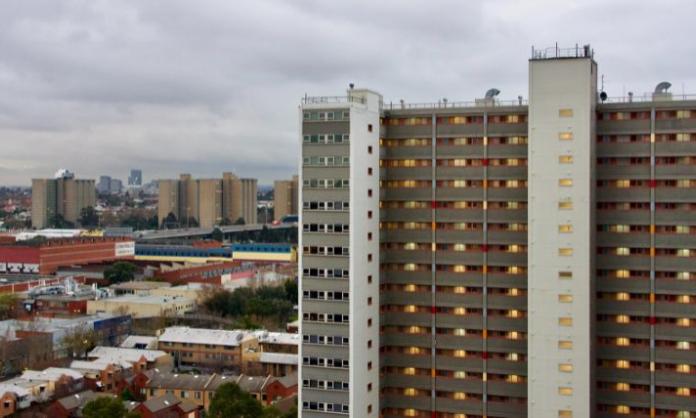Daniel Andrews, in one of his last acts as Victorian premier, announced that Melbourne’s 44 public housing towers will be demolished. In an audacious giveaway to developers, the sites will be opened up to private development.
The towers stand on prime land in the inner city in South Melbourne, Prahran, St Kilda, Williamstown, Footscray, Kensington, Flemington, Carlton, Fitzroy, Collingwood, Brunswick and Richmond. When they were built in the 1950s-1970s, these were areas in which working-class and poor people lived. But in the last twenty years they have rapidly gentrified. The housing block towers are now tiny islands of government land, “locked up” for the enjoyment of people who could not otherwise afford to rent in the area. That’s seen by policymakers as a waste.
Razing the towers will likely scatter the residents to the outer suburbs of Melbourne, out of sight. For now, the visually prominent towers might sustain a memory that the government provided cheap housing to people who, for a variety of reasons, cannot afford a home on the private market. Once they’re demolished, that can be forgotten.
The day after the announcement, government workers distributed flyers and chocolates at the Flemington estate to inform residents that their homes would be some of the first to go. But there’s no sugar coating it: this is the destruction of public housing as we know it and a bonanza for the developers.
The towers will be demolished and rebuilt one by one. The government says they are beyond repair and that the rebuilt towers will meet modern design standards and offer an extra 10 percent “social housing”. The land will also be redeveloped for private and “affordable” housing. To the 10,000 residents of public housing plus the additional 10 percent social housing, an additional 20,000 people will move into apartments built for the private market.
This is the crux of it—instead of redeveloping the sites to improve public housing and expand it to meet the need of the 55,800 people currently on the waiting list, the additional social housing dwellings are tokens to justify giving away the land to the private market.
The waiting list for social housing in Victoria has grown from about 35,000 since 2017: an increase of more than 60 percent in six years. The proposed 10 percent increase in social housing dwellings will not keep up with the growth in demand, let alone reduce the waiting list. The waiting time for people who need social housing because of domestic violence is almost two years, and they are prioritised above all other applicants. Others wait years or more than a decade.
What the property boom has shown over the last twenty years is that apartments can be built quickly. The building companies and property developers who have made a fortune during the boom in property prices over the last two decades should fund public housing.
A proposal to impose a meagre 1.75 percent levy on developers’ profits to raise $800 million to fund social housing was dropped within weeks in February 2022 because of the outcry from developers. It would have increased social housing by two-thirds to 4.5 percent of all housing by 2036, not the marginal 10 percent on existing sites.
Andrews dubiously described the demolition proposal as “the biggest urban renewal project Australia has ever seen”. By what measure? Victoria has the lowest proportion of social housing of any state—2.9 percent. Across Australia, the proportion of housing stock available for public housing has fallen steadily since 2011, from 4.8 percent to 4.1 percent in 2022. Guardian columnist Greg Jericho noted recently that in 1983, fourteen public-sector residential buildings were approved for every 100 private-sector ones. Now it is 1.7 per 100. Go figure.
“The towers have been purposefully neglected for years in order to justify their destruction”, Louisa Bassini, a tenancy lawyer working with public and community housing tenants, told Red Flag. Housing experts have questioned why alternatives to demolition were not explored site by site. A study by a not-for-profit architect and research firm, OFFICE, of the Barak Beacon site in Port Melbourne argued that the government could have saved $88 million if it had repaired rather than demolished the low-rise housing at that site. They say that the government should study the viability of redeveloping each site rather than opting to raze them all.
Urban geographer Dr Kate Shaw says that the recent redevelopment of the Atherton Gardens estate in Fitzroy is an alternative: “That was a clear and substantial increase in social housing on a public housing estate. Nobody had to move out, and it hasn’t disrupted the lovely open feel of the estate because it was built in a well-serviced corner right on the tram line. Why we are not pursuing that model leaves me gobsmacked”.
Bassini says that this highlights what the policy is really about. “To replace them with mostly private and community housing underlines why this is about dismantling public housing more broadly”, she said. “It’s a plan made in the interests of property developers and government economists, and it signals the reality that the government intends to move away from its role of providing housing for people who need it.”
Housing advocates are concerned that the dislocation of communities inside the towers will mean many never return. This was the case at the walk-ups on the Rathdowne and Lygon Street sites in Carlton in 2011. One study showed that 80 percent of residents never returned.
The Carlton sites are an example of the mixed model of privately owned and social housing. A 1.8 metre high wall keeps the public housing tenants out of the community garden built for the private tenants.
It is a portent of what is to come: the ovals, playgrounds and gardens that are a gathering space and some respite from the cramped conditions of the apartments are too good for the poor and will now be sold to those who can afford to pay for the privilege of inner-city living, with the developers pocketing the profit.









